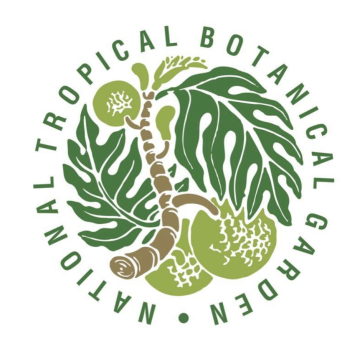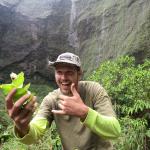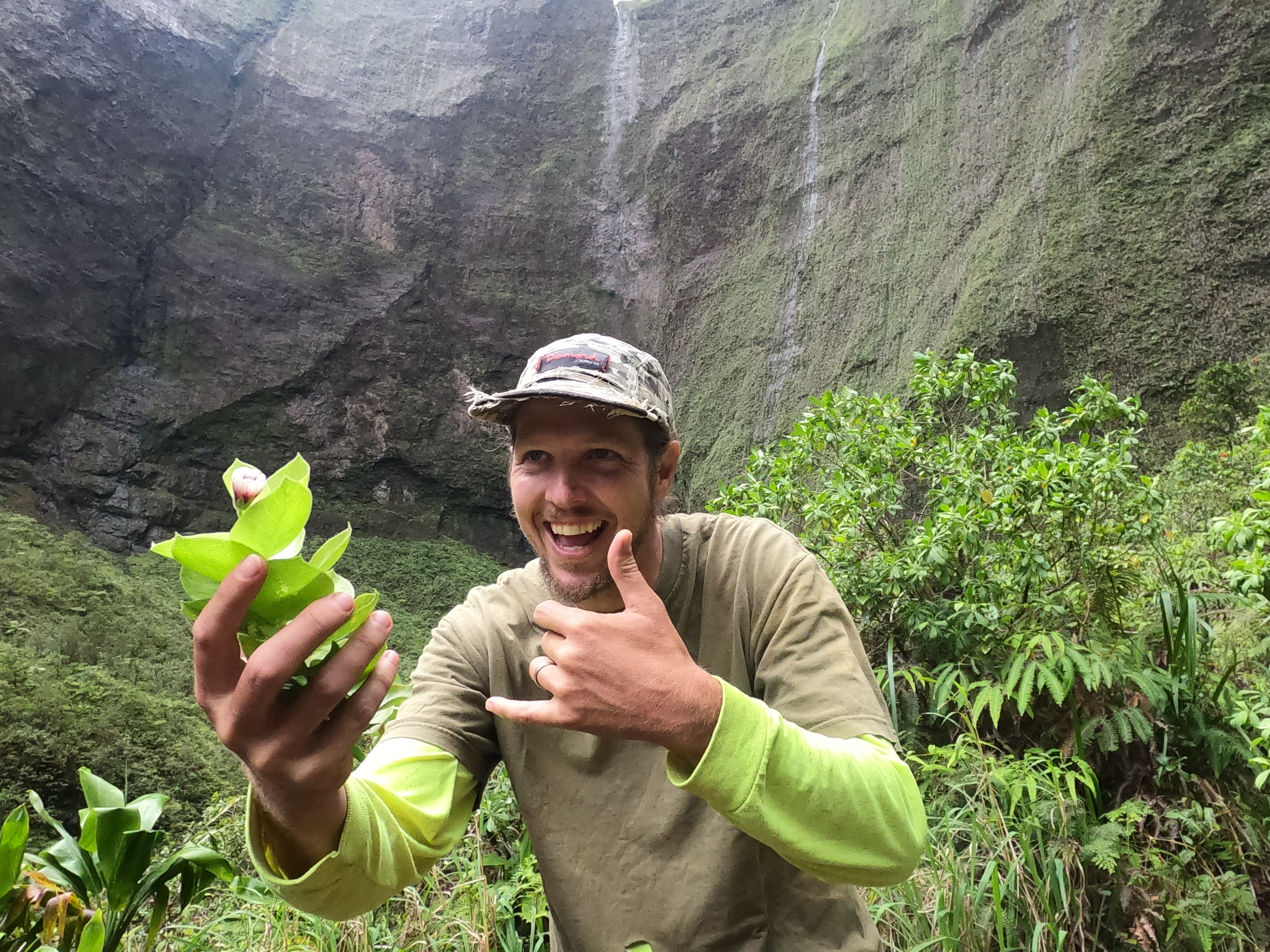
The Mamba: A Drone-based Robotic Arm to Preserve Endangered Plants in Cliff Environments
Tropical islands are home to unique floras, and host a vast number of endemic plant species. Threats have led to a significant population decrease in Hawaii, where 97% of these endemic plant species are listed as endangered, critically endangered, or extinct. Vertical cliff habitats work as refugia to protect plants from these threats. However, these habitats make conservation work particularly difficult, forcing botanists to use risky and time-consuming methods such as abseiling to access remote plant populations. We developed the Mamba, the first aerial system capable of sampling plants on cliffs. The system has allowed the collection of seeds from many critically endangered species including Hibiscadelphus woodii, as well as the recent discovery of a new species: Schiedea waiahuluensis. The conservation collections made by this tool are thriving in nurseries, demonstrating the impact on the conservation cycle for organisms located in difficult-to-reach environments, and the actions necessary to prevent plant extinction.
Context
Challenges addressed
Plant extinction is accelerating with increased human pressure, a changing climate and encroaching invasive species. Cliff ecosystems provide some protection against these threats, however, the vertical nature of these habitats makes it difficult to document and conserve the biodiversity that occurs there. Many cliff ecosystems have been unexplored or underexplored, leaving botanical darkspots where very little is known. A critical first step in conservation and protection of ecosystems is baseline knowledge of the habitat and its components. Socially, the lack of knowledge limits community engagement and awareness, particularly in remote or protected regions. Economically, inefficient or outdated methods for surveying these habitats increase costs and reduce effectiveness of conservation strategies.
Location
Process
Summary of the process
Drones are changing the way we conserve rare endemic cliff plants. They allow us to effectively survey and map critically endangered plant species, then the plants can be collected for quick transfer to our conservation nursery for propagation.
Building Blocks
Drone Survey: location, mapping, and inventory of remote plant populations
Drone tools have been instrumental as a first step in the assessment of cliff floras. Using drones to get unique viewpoints of these environments, we can now map the distribution and abundance of critically endangered endemic cliff species and expedite their conservation. Field surveys have been conducted in Hawaii, the Republic of Palau, and Madeira (Portugal) with extremely positive results.
Enabling factors
As drone technology has improved and progressed, this survey methodology has become accessible to a range of conservation practitioners. High-resolution camera sensors allow the identification of a range of plants, from large trees to small herbaceous organisms. Drone pilots can now expect to conduct up to 45 minutes of survey time in a single flight due to increased battery capacity. Usability improvements from software refinements make drones safe and effecient for beginners to use, increasing the uptake of this technology by conservation practitioners. Most importantly, as drones have become more widely available, the associated costs have been reduced, making them an amazing tool for a range of applications
Lesson learned
Drone are effective tools for the location and inventory of critically endangered species, especially in difficult-to-access environments like cliffs or tree canopies. Assessment of cliff habitats will be critical to species conservation in these areas, as baseline knowledge of where species occur can guide conservation actions, and help prioritize landscape protection.
Drone Collection: Using a drone-based robotic arm to collect inaccessible plants
The Mamba tool allows us to collect plant material via seeds or cuttings from endangered species that we have identified and mapped in the previous building block. This tool has an effective range well over 1000m, making even the most inaccessible areas available for management actions.
Enabling factors
The development of this tool by experienced robotics engineers, expedited the conservation of many species by field staff at the National Tropical Botanical Garden and partners at the Plant Extinction Prevention Program. The Mamba has an interchangeable head system that provides customizable collecting depending on the target species and the type of material necessary for conservation. Many of the components of this mechanism are 3D-printed, which is cost-effective and flexible for speedy development processes. The Mamba is built with readily available drone components which also reduces the cost and building time. The development of this tool was undertaken by P.h.D students, and integrates state of the art hardware and software solutions specifically designed for this application.
Lesson learned
When undertaking a project of this type, it is critical to have the proper pairing of experienced field staff with professional robotics engineers, as both parties provide crucial information to guide both development and effective conservation considerations. It is worth noting that the development process was iterative, leaving space for testing and revising the design, and ultimately allowing for deployment of a well-functioning and highly useful tool.
Plant Propagation: increased efficiency with improved collecting techniques
Once plants have been collected, they are transferred to our conservation nursery for propagation, or to our seed lab for viability testing and storage. We are seeing increased effectiveness of these methods with freshly collected seeds and cuttings making it quickly to our staff. As many of these individual plants were not previously known, these actions boost the genetic diversity of ex-situ collections, providing a safe place in the face of environmental degradation.
Enabling factors
Previously, botanists would need to scale the remote cliff environments where these species occur, making conservation collections difficult and time-consuming to collect and transfer back to nursery staff for propagation. With the Mamba mechanism, collections are quickly collected and transferred to the nursery.
Lesson learned
Fresh cuttings and seeds have a higher success rate in propagation.
Impacts
In the past seven years of deploying drones for the documentation and conservation of cliff taxa, we have significantly increased the known populations of at least 30 critically endangered plant species. In some cases, we have mapped numerous individual plants, leading to ten-fold increases in the known populations of these species. When paired with the newly developed Mamba sampling arm, we have collected 17 critically endangered species to aid in thier conservation. In addition, we have described one new species (perhaps the first species described from drone collected specimens) and documented a range of other botanical anomolies (range extensions, island records, and undescribed species).
Beneficiaries
So far, conservation staff and the species we work with have greatly benefited from this partnership and technology development. Many species have had their conservation status improved by this system, leading to revisions in species prioritization.
Additionally, explain the scalability potential of your Solution. Can it be replicated or expanded to other regions or ecosystem?
While this technology has been deployed effectively in a few island chains around the globe, there is a much wider opportunity for the global community at large to pick up this technology and deploy it in their regions of interest. This system is user-friendly and easy to learn for beginner drone pilots. Future software developments are aimed at further streamlining the conservation process with automated plant location or collection. Anywhere there are cliff environments, this tool could be applied. Additionally, difficult-to-reach habitats such as canopy ecosystems, densely vegetated tropical forests, offshore islets, or delicate alpine habitats could benefit from these tools.
Global Biodiversity Framework (GBF)
Sustainable Development Goals
Story
The endemic tree species Hibiscadelphus woodii was originally discovered and described in 1992 and only known from four individual plants. Soon after, a landslide killed three individuals, leaving a sole tree for the species. For 18 years, a multitude of conservation actions were attempted from cutting, grafting and even cross-pollination in an attempt to conserve the tree ex situ. The species was never able to be propagated and when the last tree died in 2009, we thought the species had been lost to extinction.
In 2019, a project deploying drone technology to survey inaccessible cliff environments in nearby areas was able to refind this species! Unfortunately, the two individuals we found growing in the middle of a 500m cliff were completely out-of-reach from botanists on rope. It was an exciting find, however, we were helpless in the conservation of the species.
When robotics experts at Outreach Robotics learned of this discovery, we quickly partnered on the project to develop a drone-based tool to help collect cuttings from vertical cliff habitats. Over the past four years, we have been co-developing, iterating new designs and field testing the mechanisms needed to make this work possible. While the COVID-19 pandemic slowed our field testing, it allowed for more focused lab time, and a highly-refined tool that is stable, efficient and ready for the mission.
In April 2024, our team accessed the remote area of Kauai via helicopter, carrying the drone mechanisms and field staff into place to make our collection. The drone and Mamba flew 300m up to the plants and was able to successfully collect cuttings from both of the known individuals. These cuttings were then hand carried by helicopter, then by airplane to another island with specialized propagation chambers in an effort to establish these plants in a nursery setting. We are excited to report that the cuttings have rooted and are now growing safely ex situ for the first time ever.
We have located, collected and grown Hibiscadelphus woodii with modern technology, and are hopeful that we have prevented the extinction of this species.
This combination of botanical expertise, paired with drone technology and cutting-edge engineering has changed the way we work in these remote, rugged, vertical ecosystems.







